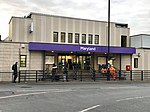West Ham Jewish Cemetery
1856 establishments in England1856 in London1866 establishments in England21st-century attacks on synagogues and Jewish communal organizationsBuildings and structures completed in 1866 ... and 12 more
Cemeteries in LondonCemetery vandalism and desecrationCommonwealth War Graves Commission cemeteries in EnglandEngvarB from May 2019Jewish cemeteries in the United KingdomJewish mausoleumsJudaism in LondonMausoleums in EnglandMonuments and memorials in LondonRenaissance Revival architecture in EnglandRothschild familyWest Ham
West Ham Jewish Cemetery is a cemetery for Jews in West Ham in the London Borough of Newham, England. It was established in 1856 by the New Synagogue on Great St. Helen's, soon joined by the Great Synagogue in Duke's Place, both of them London congregations.There are a number of notable people buried here, in a graveyard visually dominated by the imposing Rothschild Mausoleum. One section contains graves removed to this burial place from the former Hoxton burial ground of the Hambro Synagogue when that site underwent urban redevelopment. The oldest legible tombstone in this section dates from 1794.
Excerpt from the Wikipedia article West Ham Jewish Cemetery (License: CC BY-SA 3.0, Authors).West Ham Jewish Cemetery
London
Geographical coordinates (GPS) Address Nearby Places Show on map
Geographical coordinates (GPS)
| Latitude | Longitude |
|---|---|
| N 51.5528 ° | E 0.0123 ° |
Address
Rothschild Mausoleum
E15 1SX London (London Borough of Newham)
England, United Kingdom
Open on Google Maps






